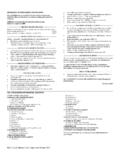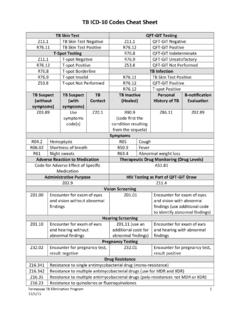Transcription of Comparison of pharmacokinetics and efficacy of oral and ...
1 Comparison of pharmacokinetics and efficacy of oral and injectable medicineOutline Background Results Antibiotics Non steroidal anti- inflammatory drugs (NSAIDs) Vitamins Conclusions and recommendations Outline Background Results Antibiotics Non steroidal anti- inflammatory drugs (NSAIDs) Vitamins Conclusions and recommendationsInjections given with sterile and reused equipment East CrescentSouth AsiaEastern Europe andCentral AsiaChina and PacificSouth East AsiaEast and Southern AfricaWest AfricaSouth America (highermortality)Central EuropeSouth America (lowermortality)RegionsNumber of injections per person and per yearInjections given with non-sterile equipmentInjections given with sterile equipmentInjections: A dangerous engine of disease Hepatitis B Highly infectious virus Highest number of infections (21 million annually) 32% of HBV infections Hepatitis C More than 2 million infections each year More than 40% of HCV infections HIV More than 260 000 infections Approximately 5% of HIV infectionsSimonsen et al.
2 WHO 1999 Reported common conditions leading to injection prescription Infections Fever Upper Respiratory Infection/ Ear Infection Pneumonia Tonsillitis pelvic inflammatory disease Skin Infections Diarrhea Urinary tract infection Asthma Other Malaise Fatigue Old AgeReported injectable medicines commonly used Antibiotics Anti- inflammatory agents / Analgesics VitaminsSimonsen et al. WHO 1999 Reported factors leading to injection overuse Prescriber-associated factors Perceptions regarding injections Assumptions about patient`s expectations Patient-associated factors Perceptions regarding injections Therapeutic expectation System issues Lack of effective oral medications Financial implicationsReeler et.
3 Al. WHO 2000 Stoica et al. SHEA 1999 Reported prescribers reasons for the use of injections pharmacokinetics Strength of injectables Rapid onset of action Poor intestinal absorption of oral medications Absence of effective oral medications Other Recommendations by Professors/Ministry of Health Direct observed therapy Patient care issues Inability of patient to take medications by mouth Patient s desire for injection Chronic condition of patient ( illness, malnutrition or alcohol abuse)Misconceptions about injections among prescribers Oral absorption is variable, whereas parenteraladministration assures high drug levels Injectable drugs are stronger than oral drugs Injectable drugs have more rapid onset of action Chronic conditions (malnutrition)
4 Of patients leads to poor oral absorption of drugsProvidersMisunderstanding between patients and prescribers leading to injection overuse 80-95% of patients do not prefer injections Over-prescriptionDemandPatients perception that providers prefer injections5-20% of patients prefer injectionsProviders perception that patients prefer injectionsAddressing Cognitive Dissonance Using Patient-Provider Interactional Group Discussions, Indonesia, 19930%20%40%60%80%100%135791113151719212 325 MonthsProportion of visits with injectionControl GroupInteractionalGroupDiscussionSource: Long-term impact of small group interventions, Santoso et al.
5 , 1996 Objectives of the Study Primary objective Provide an evidence base for decision making in prescribing injections Secondary objective Compare pharmacokinetics of oral and injectable drugs Describe the impact of malnutrition on drug pharmacokinetics Compare the effectivenesss of oral and injectable drugs in randomized clinical trials Compare the cost of oral and injectable drugsLiterature review methods Medline Cochrane reviews Pharmacology textbook reviews Micromedex Outline Background Results Antibiotics Non steroidal anti- inflammatory drugs (NSAIDs)
6 Vitamins Conclusions and recommendations Parameters commonly used in pharmacokinetics Parameters affected by mode of administration Absorption Bio-availability Peak serum concentration Time to peak serum concentration Parameters unaffected by mode of administration Half-life Clearance Distribution Metabolism Protein bindingIV 100% bioavailableFactors influencing absorption and bioavailability of medications Oral route Food consumption Cation interaction Gastric pH Intrinsic absorptive capabilities of digestive tract First pass hepatic metabolism IM route Injection site Diluent Solubility of drug Concentration of drug Total surface area for diffusion Blood flow to muscle injectedOutline Background Results Antibiotics Non steroidal anti- inflammatory drugs (NSAIDs) Vitamins Conclusions and recommendationsPeak serum concentration of selected oral, IM and IV antibiotics Class of AntibioticOralIMIVN atural Penicillin++-+++++Aminopenicillin++++++F luoroquinolones+NA+Chloramphenicol+++++S ulfonamides+NA+Rifampin+NA++Source.
7 MicromedexTime to peak serum concentration by different modes of administration Oral 30min 6hrs IM 30min 3hrs* IV End of infusion* Natural penicillin time to peak serum concentration 4-24 hrsEffect of malnutrition on the pharmacokinetics of antibiotics Children Decreased clearance Larger area under the curve Potential toxicity Adults Lower absorption (may be overcome by larger doses) Increased clearance Potential need for more frequent administration Injected and oral antibiotics in the treatment of mild to moderate infections Clinical outcomeBacterial outcomeNo.
8 OfstudiesStudiesreporting equivalenceStudiesreporting parenteralbenefitStudiesreporting equivalenceStudiesreporting parenteralbenefitOtitis media 44/40/4 NANAP neumonia 32/31/3*0/11/1*STD 132/20/212/120/12 UTI 53/30/32/30/3 Osteo-myelitis 21/10/12/20/2*Only in subset of study patientsSequential and prolonged parenteral antibiotics in the treatment of severe infections Clinical outcome Bacterial outcomeNo. ofstudiesStudiesreportingequivalenceStud iesreportingparenteralbenefitStudiesrepo rtingequivalenceStudies reportingparenteralbenefitUTI 22/20/21/20/2 Pneumonia 33/30/32/20/2 Skin infection 21/20/22/20/2 Febrilecytopenia 22/20/21/10/1 Mixed 44/40/44/40/2 Compared cost of selected oral and parenteral antibioticsDrugRelative cost of parenteral:oralper equivalentDoseAmpicillin3:1 Cloxacillin4:1 Chloramphenicol5.
9 1 Outline Background Results Antibiotics Non steroidal anti- inflammatory drugs (NSAIDs) Vitamins Conclusions and recommendations ClassNSAIDB ioavailability(%)Time to serum peak(hours) 100100103 OxicamMeloxicam89---1 NAFenamatesNiflumic of the phamacokinetics of different NSAIDs by route of administrationAuthorsDiagnosis Oral dosage andfrequencyInjectabledosage andfrequencyConclusionsCombRheumatoidart hritisMeloxicamMeloxicam IMBoth effective and well-toleratedAuvinetAcute SciaticaMeloxicamMeloxicam IMBoth effectiveTurnerPain after surgeryR.
10 IndometacinKetorolac IMNo significant difference in painShrestaAcute goutIndometacinKetorolac IMBoth similar in the reliefKumaraMolar surgeryTenoxicamTenoxicam IVBoth equally effectiveTuomilehto AdenoidectomyKetoprofenKetoprofenNo differences in pain scores,SuperviaRenal colicPiroxicam,Diclofenac IMNo significant differenceEvansDuctus arteriosusIndometacinIndometacin IVIntravenous form superiorRandomized clinical trials comparing the outcome of oral and injectable NSAIDs in various clinical situationsOutline Background Results Antibiotics Non steroidal anti- inflammatory drugs (NSAIDs) Vitamins Conclusions and recommendations pharmacokinetics of selected vitamins Oral Administration IM Administration Absorption Time to peak serum conc.



















